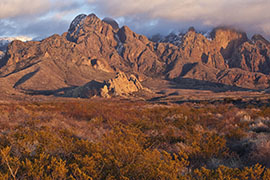- Slug: BC-CNS-Monument Money,660
- StoryMap available (embed code below)
- Photos available (thumbnails, captions below)
By SARA WEBER
Cronkite News
WASHINGTON – National monuments designated by President Barack Obama are adding $156 million to their local economies a year, according to a study of the 10 most recently named monuments spanning Western states.
The report, released Wednesday by the Small Business Majority, based that number on estimates of money spent on entrance fees, meals, lodging and other retail expenses by the 3.9 million visitors each year to those monuments between 2011 and 2015. That activity also helped support around 1,820 jobs each year, the study said.
It was quickly assailed by business and property rights groups, who said it did not paint a complete economic picture, and just as quickly embraced by public lands advocates.
That polarized reaction is precisely why the study was needed, said the report’s authors.
“We thought now was the perfect time because of all the conversation in Washington, D.C., about the importance of national monuments and the Antiquities Act, especially in the West, where there are a lot of small-business economies,” said Rhett Buttle, president of the Small Business Majority.
None of the 10 monuments studied is in Arizona, but tribes in the Four Corners are pushing for Obama to use the Antiquities Act to declare 1.9 million acres in southeastern Utah as the Bears Ears national monument.
While there are currently no plans for a presidential designation in Arizona, Rep. Raul Grijalva, D-Tucson, said the study can help make the case for congressional approval of his bill to create a national monument of another 1.7 million acres around the Grand Canyon. The report will “only help the argument that the Grand Canyon and surrounding area should be made into a monument,” he said.
But some northern Arizona business and elected officials aren’t impressed with the argument.
“We are against the federal government taking any more of the state’s land,” said Stuart McDaniel, vice president of government affairs at the Greater Flagstaff Chamber of Commerce. “The Grand Canyon received record attendance this year, and our hotels and restaurants have done very well.”
Mohave County Supervisor Buster Johnson pointed to a disclaimer in the report as reason enough to doubt the numbers.
After saying local businesses are “uniquely positioned to derive economic benefit from the travel, tourism and outdoor recreation,” the report adds a disclaimer that it could not “quantify the precise impact of national monument designation on nearby small businesses.”
Johnson said tourism is just one element in a healthy local economy.
“You can’t sustain a community on tourism jobs,” Johnson said Wednesday. “It takes away jobs like mining and ranching, and the majority of tourism jobs don’t pay as well.”
McDaniel echoed that idea, saying that if more land were designated as a monument, farmers near the Grand Canyon “would be affected in a negative way.”
The report broke down which activities attract the most visitors, with hiking and biking at the top of the list. Johnson worried that national monuments can mean restrictions on hunting. Even though it was well down the list of popular activities, hunting still drew a little over 68,000 visitors to the monuments between 2011 and 2015, according to the report.
“I’m not arguing that tourism doesn’t make money, but they’re cutting off access to things,” Johnson said. “It says hunting is a factor, but what kinds of hunting do they allow?”
Steven Smith, a spokesman for Rep. Paul Gosar, R-Prescott, dismissed the study, saying it “has about as much credibility as a report published by the DNC (Democratic National Committee) and should be treated like the propaganda that it is.”
But Grijalva, the ranking member on the House Committee on Natural Resources, said Wednesday that protecting public lands is a “win-win situation” by creating revenue and preventing environmental damage.
“We see ongoing benefits at these monument sites,” he said Wednesday. “It’s not an extraction, like in a mine shaft, where they do what they do and then leave. It’s a perpetual set of revenue that only grows.”
^__=
_Web Links:
_ Small Business Majority Report: http://www.smallbusinessmajority.org/small-business-research/downloads/040616-Economic-Impacts-of-Obama-Administration-Natural-National-Monuments.pdf
_ The Antiquities Act: https://www.nps.gov/archeology/sites/antiquities/about.htm
_ The Greater Flagstaff Chamber of Commerce: http://www.flagstaffchamber.com/
_ Story map embed code: <iframe src=”https://s3.amazonaws.com/uploads.knightlab.com/storymapjs/eecbb57d22e91a7ffde42ff341f6b8a1/report-economic-impacts-of-obama-administration-natural-national-monuments/index.html” frameborder=”0″ width=”100%” height=”800″></iframe>
^__=
SIDEBAR:
Monument money
A Small Business Majority report claims the 10 newest presidentially designated national monuments spun off $156 million in economic benefits, from lodging and food to “secondary impact,” or the recirculation of tourists’ money in the local economy.
– Secondary impact: $57.4 million
– Lodging: $38.4 million
– Restaurant: $21.4 million
– Groceries: $15.2 million
– Recreation: $11.6 million
– Gasoline: $6 million
– Other retail: $5.4 million
– Local transport: $1 million
^__=
The Organ Mountains-Desert Peaks Monument in New Mexico, one of 10 monuments created by President Barack Obama studied in a new report that said the monuments generate $156 million in business for lcoal communities. (Photo by Bob Wick/Bureau of Land Management)
The two buttes of the Bears Ears, near the Natural Bridges National Monument in southeastern Utah. Tribal groups in the region are pushing to have 1.9 million acres around Bears Ears preserved as a national monument. (Photo courtesy the U.S. Geological Survey)

